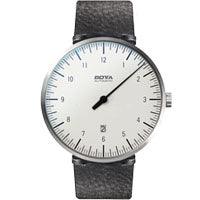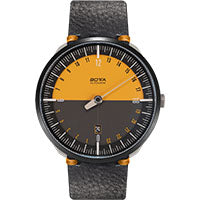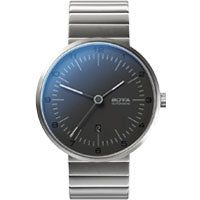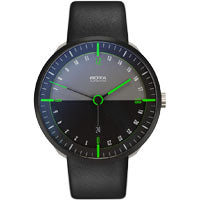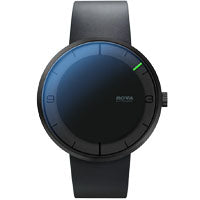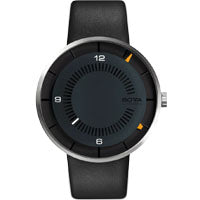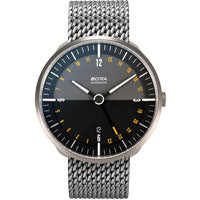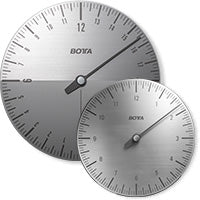Design in the service of creative clarity
Exactly 100 years ago, the legendary BAUHAUS was founded in Weimar as an interdisciplinary design school and research institution. The design theory that was developed there had a lasting influence on the world in which we live. Buildings, furniture and everyday items inspired by the spirit of the Bauhaus are to be found everywhere.
2019 is the Bauhaus centenary year, and it seems more than ever that every second manufacturer has some kind of historical connection with this institution hat. However, very few products really stand up to any detailed scrutiny of their Bauhaus credentials, explains the designer Klaus Botta, an Offenbach University of Art and Design graduate who himself continues to uphold the Bauhaus principles. He believes that the fundamental values of the Bauhaus remain valid but should be adapted to the needs of the present day.
He has coined the term “genetic design” as a response to the complex requirements of modern markets. His design philosophy gives even greater consideration to the specific motives of the user. Product designer Botta believes that product design, as an interdisciplinary field, should be integrated at a very early phase of product definition – the genetic phase – so that designs can be tailormade for companies, thereby achieving genuine added value as compared with what is currently on offer.
The Bauhaus – looking back
The Bauhaus is seen as the cradle of classical Modernism in art and architecture. It was established in 1919 by the architect Walter Gropius as a teaching institution in Weimar. The idea was for gifted young people to combine disciplines such as architecture, art and crafts to form a symbiotic entity. In addition to teaching, an important role was played by experiments and research.
Architects and artists from many European countries taught at the Bauhaus, including Ludwig Mies van der Rohe, Paul Klee, Wassily Kandinsky and Oskar Schlemmer. The students also constituted an international artistic avant-garde.

Wassily Kandinsky – Komposition VIII, 1923, Solomon R. Guggenheim Museum, New York
After the Bauhaus moved to Dessau in 1925, the original artistic orientation became more technical and practical in nature. The Bauhaus regarded itself as an enlightened countermovement to the mishmash of styles that prevailed at the time. Architecture and design were very much influenced by the still widespread playful and ornamental Art Nouveau and Art Deco styles, as well as by the variety of styles popular in earlier times.

Room by Eduard Gärtner (Victorian Era)
It was particularly the second Bauhaus director, Hannes Meyer, who shaped the typically functionalistic and technical orientation of this teaching and research institution. The new approach was characterized by a strict clarity of design combined with socially motivated objectives. Humans were to be the focus, not products covered with ornamentation or rooms overburdened with details.

Barcelona Chair by Ludwig Mies van der Rohe from 1929
The third Bauhaus director, the architect Ludwig Mies van der Rohe, also took this pragmatic and functional design approach to the next stage. He promoted a straightforward architectural aesthetic.
Alongside this renunciation of ornamentation, another phenomenon of that era generated huge demand for design: advancing industrialization. Whereas products had hitherto been manufactured mainly by craftsmen as individual items, industrial production brought forth goods that were produced en masse and were all identical, like peas in a pod. Industrial mass production created a design vacuum. The new technical possibilities raised the question of what constitutes meaningful design. New production methods made new forms possible – and thus a new product language.
This demand was met by the teachers and students of the Bauhaus. They developed a new emphatically purpose-oriented approach to designthat is normally described using the term “functionalism”. It was this second phase that resulted in many of the typical items of Bauhaus furniture such as Marcel Breuer’s tubular steel chairs and other consumer goods, as well as influential architectural works such as the “people’s flats” or “Laubengang houses” in the experimental Dessau-Törten housing estate designed by Hannes Meyer.
The Bauhaus was disbanded for political and economic reasons in 1933.
20 years later, Max Bill, Inge Aicher-Scholl and Otl Aicher founded the “Ulm School of Design”. It perpetuated the philosophy and design theory of the Bauhaus in what is known as the “Ulm model” and continued to develop it until 1968.
The Ulm School produced many influential products, as well as a large number of renowned designers who played a key role in shaping the design landscape and industrial culture in the second half of the twentieth century.

Braun tube radio model SK 2 from 1960
Photo:Wikimedia
In 1970, the former Werkkunstschule Offenbach spawned the “Offenbach University of Art and Design (HFG)” – the third institution to be founded in the Bauhaus spirit. A number of HfG Ulm graduates such as Jochen Groß, Bernhard E. Bürdek and Richard Fischer expanded the teachings of the Bauhaus and the HfG Ulm and developed the “Offenbach approach” that continues to influence design theory at European universities of design to this day.
The strictly purpose-oriented and functional design maxim of the Bauhaus was extended to include product language functions. Besides the “practical function” (what is the purpose of a product?), this saw aesthetic and semantic functions added:
- formal aesthetics – the aesthetic qualities of the product
- sign function – illustrating the functions of assemblies and operating elements
- symbol function – the symbolic messages which a product conveys
The Bauhaus and its designers today
100 years after the founding of the Bauhaus, the concept of “stripping things down to the essentials” is more relevant than ever. After all, never before have we been exposed to such an excess of stimuli, and never before have we yearned more for our daily lives to be simplified.
Following the Bauhaus ideal, Klaus Botta’s design approach has always been characterized by a consistent desire to simplify. “Simplicity is the true luxury of our time” is one of his core theories, according to which he intelligently reduces the complexity of products with a view to improving quality of life. Another issue close to Botta’s heart is to make products durable in both material and non-material terms. A good product will last a long time, and will also retain its design attractiveness.

One-hand watch UNO 1986 and UNO 2019
The designer Klaus Botta attracted particular attention when he designed the UNO, the first modern one-hand watch. Featuring just one hand, the UNO is intended to enable a relaxed and more humane approach to time. True to its basic design concept, the watch has been manufactured according to almost exactly the same design ever since 1986, and has come to be regarded as a design classic that has extended the Bauhaus watch landscape to include the one-hand watch dimension.

